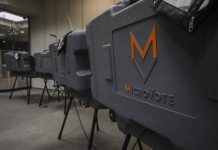The Atterbury-Bakalar Air Museum is selling the nose cone that was attached to the C-119 “Flying Boxcar” aircraft it purchased in 2019 and is now on display near Columbus Municipal Airport.
The nose cone, which is 53 inches wide, 63 inches long and 67 inches top to bottom as mounted on the fuselage and weighs less than 80 pounds, has been on sale for $200 for over a week, but the museum hadn’t received any serious inquiries yet, said museum president Nick Firestone.
Nose cones are located at the foremost point of an aircraft and are designed to minimize aerodynamic drag. They also often house radar and other equipment that can transmit electronic signals.
The particular nose cone that the museum is selling is different than the nose cones that were typically on C-119s when they were stationed in Columbus — and made the aircraft “look a little bit like a porpoise or beluga whale,” said Skip Taylor, C-119 project leader.
In its place, museum volunteers have installed a conventional nose cone that was given to them by officials from March Air Reserve Base near Riverside, California, Taylor said.
The proceeds for the sale will go to the C-119 project fund.
“We thought if somebody is creative enough, they might be able to turn it into a chair, or one of our guys (said), ‘Well, maybe you could modify it and turn it into a dog house,’” Firestone said. “You know, they’re just different things you might be able to do with it.”
The roughly 38,000-pound plane, which is not airworthy, was taken apart at an airport in Greybull, Wyoming after it was purchased in 2019. The parts — including the iconic fuselage that gave the aircraft its nickname — were loaded onto trucks and driven 1,460 miles to the Columbus Municipal Airport. The final pieces of the aircraft arrived about a year ago.
The plane was moved to its display site just south of the McDonnell Douglas F-4 Phantom II aircraft near Columbus Municipal Airport last month.
The C-119, also known as the “Flying Boxcar” due to the unusual shape of its fuselage, was in service with the U.S. Air Force from 1947 to 1972 and was designed to carry cargo, personnel, litter patients and mechanized equipment. The aircraft was also used to drop cargo and troops using parachutes, according to the Strategic Air Command and Aerospace Museum.
The aircraft is about 86-feet long, has a 110-foot wingspan and is 27-feet tall at the tail. The Flying Boxcars were powered by two Wright R-3350 Duplex Cyclone radial engines, each with 3,500 horsepower, and could reach a maximum speed of 296 miles per hour.
The U.S. Air Force extensively used C-119s during the Korean War from 1950 to 1953. Retired C-119s were also used as air tankers to fight wildfires in the United States.
The particular C-119 purchased by the museum was built in Hagerstown, Maryland, for the Canadian Air Force, Taylor said. The aircraft was later acquired by Hawkins & Powers and used to fight forest fires. Its last known flight was in 1990.
The Flying Boxcars are of particular historical significance to Columbus, according to museum volunteers. Here, the pilots referred to them as the “Dollar Nineteens,” according to museum records.
From 1957 to 1969, 36 C-119s for the 434th Troop Carrier Wing were stationed at Bakalar Air Force Base, which is now Columbus Municipal Airport. The C-119s were a staple in Columbus, flown out of the base longer than any other aircraft.
Manufacturers Fairchild and Kaiser built 1,151 of the C-119s from 1949 to 1955. However, only around 40 Flying Boxcars are still left today, most of them in museums across the country or in a scrap yard.
The Atterbury-Bakalar Air Museum purchased the plane for $15,000 in May 2019.
[sc:pullout-title pullout-title=”How to buy the nose cone” ][sc:pullout-text-begin]
For inquiries about the nose cone, email the Atterbury-Bakalar Air Museum at [email protected].
[sc:pullout-text-end]




